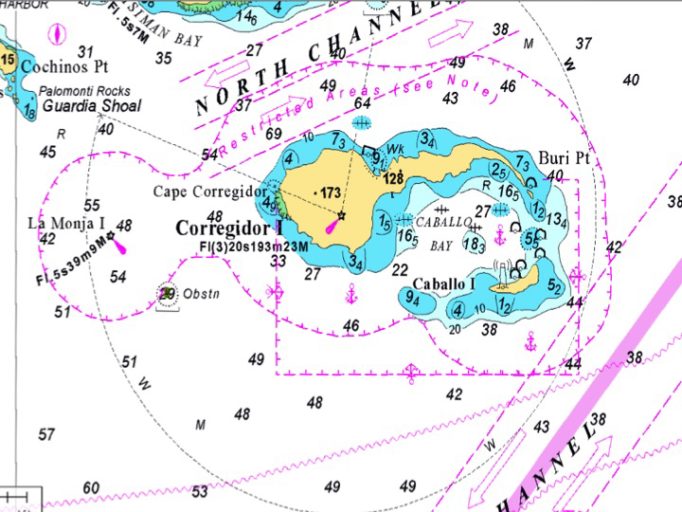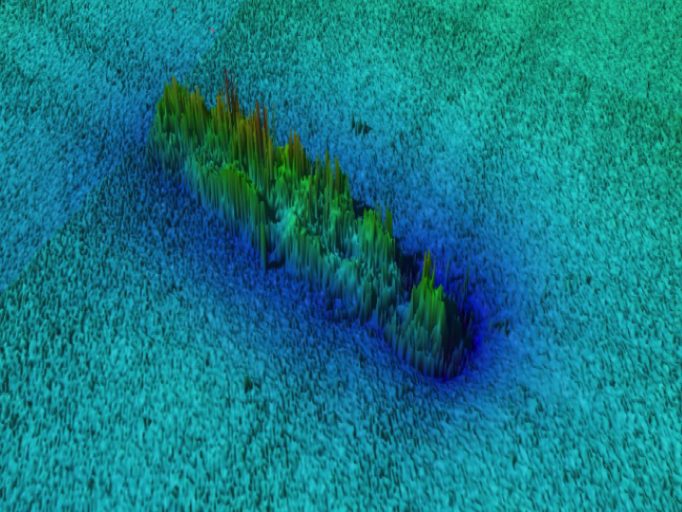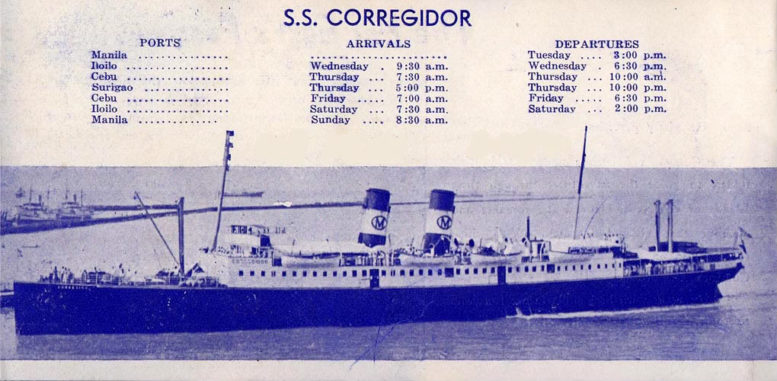In the Mar-Apr 2016 (MR16-2) issue, I wrote about the sinking of SS Corregidor on 17-December-1941 that resulted in the death of my late father, an Army Lieutenant in the Corps of Engineers on that fateful night, as he sailed on the SS Corregidor to rejoin his unit in Davao. He was the Assistant City Engineer and was called to active duty and given command of the Second Davao Training Cadre earlier that year.
I also mentioned that in 2003 I learned that the Manila-based Malayan Towage Co. had a deep submergence vehicle (DSV) coming in, and had gotten a commitment from one of its executives that they would consider a sortie between La Monja Islet and Corregidor Island to seaward. As it turned out, that did not happen. I also mentioned in January 2016 that an associate led me to a website (www.corregidor.org) that contains lots of information, accounts and opinions about the forces and their life on Corregidor, including the SS Corregidor’s sinking. I recommend that site to US and Philippine historians and researchers. I had concluded that commentary stating:
Perhaps someday, we can find out where the SS Corregidor lies, and maybe recover much of what perished with it. The Titanic took almost a century; the Musashi, off Romblon took 70 years. The Corregidor, with much lesser area and depth, should have taken much less time.
I will get to this point later. Meanwhile, there is an interesting – and intriguing – aspect of this disaster. In the course of my research, I got acquainted with an American who was investigating the cause of the accident, and he opined to me on 16-December-2015 (the eve of the 74th anniversary of the sinking):
…You will find a fair amount on this (SS Corregidor) forum concerning the tragedy. My personal belief is that the information released at the time was false, as an honest investigation into the affair would have uncovered some unsavory facts which the United States did not want known. Generally, you can search “SS Corregidor” using the forum search facility or you can google search “SS Corregidor” and “corregidor.org” jointly.
He adds further on:
I have been doing the Corregidor websites for over a decade now. Sometimes I can get a bit outspoken when I see things that I should really bite my tongue about. (I am critical of the way Corregidor, Fort Drum and Caballo Islands are handled, for example.)…
I reviewed my writing on the SS Corregidor, particularly the post of 12-April-2012. I was tiptoeing through a minefield there, wasn’t I? The “minefield” he was referring to concerns delving into discussions relating to claims on the culpability of Col Paul D Bunker USA, who was commanding the Coast Artillery Corps (CAC) unit that had control of the Corregidor minefields.
He asked me further on:
How much have you tracked down on the sinking? http://corregidor.proboards.com/thread/1168/loss-corregidor is the start of the public side of it. I had done some internet browsing on it, and behind the scenes had encouraged some of the players to be more outspoken about it. My private view was that Col. Bunker may well bear some significant direct responsibility for the tragedy. If you have his published diary, you’ll note that his editor has left out everything which happened leading up to the war, and all which occurred in December. That there is nothing in the published diary about the sinking indicates that his editor (a relative) has covered up what Bunker could have been reasonably expected to write.
Thus we are not filled in on the details of the dispute between the Army and the Filipino skippers and harbor captains, because it seems to me that Bunker had some very strong (negative racial) views, and may well have been of a mind not to bend the rules, just to show them who is boss. In doing so, I think Bunker may well have committed a crime. Essentially, this is what Captain George Steiger alleges.
There was another aspect. In trying to justify that the US Army had no control over the tragic accident, the Corregidor command used the reported presence of the Japanese submarine in the area during that period, which has not been proven as the plausible cause of its sinking. Pointing to Col. Bunker’s culpability for not acquiescing to recommendations of his officers to turn off the electric mines is a difficult, proposition, as per one dedicated Australian researcher emailed to me in 2015,
In a truthful world, one which searches for truth and does not kneel to authority, it would be interesting to see a screenplay written in which Bunker, in a POW camp, faces a court-martial or board of enquiry to examine his decision not to turn off the mines. Bunker, of course, died in Japan and every aspect of his personal conduct became moot, in a legal sense, but not the lessons, which the US should have learned about many aspects of how a militarily driven policy may conflict with the very interests of those it purports to assist or protect.
There’s lots of JAG people who are familiar with war crimes with respect to the Uniform Code of Military Justice, but I am of the view that the UCMJ doesn’t apply to the circumstances of the SS Corregidor (the sinking predates UCMJ applicability), and thus the level of Bunker’s responsibility would be measured by the old rules which applied in the Army from around the time of the Civil War. So a moral guilt, but maybe not a legal one. From a dramatic point of view, if one US citizen was proven to have been on that ship, Bunker could have been charged with murder.
I don’t think entertainment America is ready for another courtroom drama, which serves as a background for an examination of the way US foreign policy operated in the last century, and by extension, today.
I have long wondered whether the Filipino Authorities ever got closer to the truth than they seemed to accept. Did they just swallow the Japanese sub excuse, or was that their cover story too? Were they in on the cover up, or were they the target of the cover up? Or was it the confidence of the Filipino population in the US defending them against the Japanese? Or is it that everything disappeared under the carpet and that nobody knows anything any more?
But my passion is really just to convince the Philippine government to do whatever it takes to locate the resting place of the SS Corregidor, raise parts of it and its cargo and salvage whatever can be salvaged (and this would be fruitful historically and financially for the government). There were Philippine Army troops who died there, bringing along weapons and ammunitions for units in the field, and some, including my late father, just returning to their units after the briefings on War Plan Orange and other necessary actions.
The location part has been done, and surprisingly it is not in deep waters, confirming an account I read from a record written by the late former Ambassador Jose E Romero (father of the former Ambassador and columnist Jose V Romero Jr., the late Chairman of the Philippine Council for Foreign Relations (PCFR), who just passed away two weeks ago. Romero Sr., in his account stated that the ship had touched bottom, just before he got away and swam upwards, from that fateful incident just past midnight, 17-December-1941, and rescued by a USN PT boat.
The NAMRIA had actually located it in 2011. The location was given to me by Capt Herbert Catapang of the Coast and Geodetic Survey Department of NAMRIA, Shown in a region extracted from NAMRIA chart 1501. Highlighted in red ellipse is the position of a 29-m depth obstruction, which was investigated using high-resolution multi-beam echo sounder data acquired on 27-October-2011. The charted obstruction is about 2 km (1.75NM) SE of La Monja Island. Adjacent sea bottom configuration is generally flat, perhaps composed of fine sediment aggregates.
The geographic coordinates in WGS-84 is: Lat: 120 32’ 8.59” E Long: 14 21’ 52.77” N depth: 48.82m, about only 200 feet of depth! (Source: NAMRIA)
A perspective model (false-color bathymetry) of the observed wreck by NAMRIA, generated using advance survey data analysis software. The dark-blue region around the obstruction indicates gradual depression of soft sea bottom material due to obstruction’s weight. (Source: NAMRIA)
Way ahead. In order to put this issue to rest, we need to take action. I am suggesting that the government act on the survey, salvage and take inventory of whatever can be recovered from the wreck of the SS Corregidor. Many valuable government and private properties may still possibly be laying there.
This is not difficult to do, and the worst that could happen would be to realize that after all these years, the post World War II salvors from 1946 to the early ‘50s had already done so and gotten all the artifacts worth saving.
